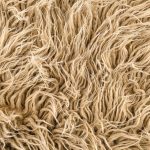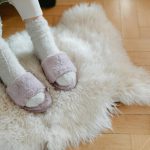Looking to learn how to hook rugs with wool fabric? You’ve come to the right place!
This article will guide you through the process of selecting the right wool fabric, preparing it for rug hooking, and choosing the best hook for the job.
With step-by-step instructions and helpful tips, you’ll be able to create beautiful rugs with consistent loops.
Plus, we’ll cover finishing techniques and how to care for your wool fabric rugs.
Let’s get started!
Table of Contents
Selecting the Right Wool Fabric for Rug Hooking
You’ll want to make sure you’re selecting the right wool fabric for rug hooking. When it comes to rug hooking techniques, the choice of wool fabric plays a crucial role in the overall success of your project. There are certain characteristics you should consider when selecting the fabric.
Firstly, the wool fabric should be sturdy and durable. This is important because rug hooking involves pulling loops through the fabric repeatedly, which can put strain on the material. Look for wool fabrics that have a tight weave and are resistant to fraying.
Secondly, the fabric should have a good grip. This means that it should hold the loops securely in place, preventing them from slipping or unraveling. Avoid fabrics that are too slippery or have a loose weave, as they may not provide the necessary grip.
Additionally, the wool fabric should be soft and comfortable to work with. It should be easy to pull the loops through the fabric without causing any strain on your hands or fingers.
Lastly, consider the color and design of the wool fabric. Choose colors and patterns that complement your rug hooking design and add visual interest to the finished piece.
Preparing the Wool Fabric for Rug Hooking
To get your wool fabric ready for rug hooking, start by washing and drying it thoroughly. This ensures that any dirt, oils, or chemicals are removed, and the fabric is clean and ready for the next steps. Once the fabric is clean, there are a few techniques you can use to prepare it for rug hooking:
-
Blocking: Lay the fabric flat and use blocking pins or weights to stretch it to the desired size and shape. This helps to prevent distortion and ensures straight edges.
-
Cutting: Use sharp scissors or a rotary cutter to cut the fabric into strips or shapes that are suitable for your rug hooking project. Make sure to cut with the grain of the fabric to prevent fraying.
Troubleshooting common issues with wool fabric rugs:
-
Shrinkage: If your wool fabric shrinks after washing, try blocking it again to stretch it back to its original size.
-
Color bleeding: To prevent colors from bleeding, soak the fabric in cold water with a color fixative before washing.
Choosing the Best Rug Hook for Wool Fabric
When choosing the best rug hook for wool fabric, there are a few key points to consider.
First, ensure that the hook material is compatible with wool fabric to avoid snagging or damaging the fibers.
Secondly, the size of the rug hook is important, as it should be suitable for the thickness of the wool fabric being used.
Lastly, an ergonomic handle design can greatly enhance your rug hooking experience by providing comfort and reducing hand fatigue.
Hook Material Compatibility
The wool fabric you’re using for hooking rugs should be compatible with the hook material. This will ensure that your rug hooking experience is smooth and that your rugs turn out durable and long-lasting. Here are some important points to consider:
-
Hook Material Durability:
-
Choose a hook material that is strong and durable, such as stainless steel or high-quality metal, to withstand the repeated use on wool fabric.
-
Avoid using materials like plastic or low-quality metal, as they may break or wear down quickly, compromising the quality of your rugs.
-
Alternative Rug Hooking Materials:
-
If you prefer a softer feel or want to experiment with different textures, consider using a wooden hook. It can provide a gentler touch on the wool fabric while still being durable.
-
Another alternative is a latch hook, which allows for different loop lengths and can create unique patterns and designs on your rugs.
Rug Hook Size
Using the right size hook is crucial for achieving the desired texture and tightness in your rug. When working with wool fabric, you have several hook options to choose from.
The size of the hook will determine the size of the loops and how tightly packed they are. For finer details and a tighter weave, a smaller hook, such as a size 8 or 9, is recommended.
If you prefer a looser, more textured look, a larger hook, like a size 10 or 11, will create bigger loops. Experimenting with different hook sizes will allow you to find the perfect balance between texture and tightness for your rug.
Remember to adjust your rug hooking techniques accordingly to ensure a consistent and even finish.
Ergonomic Handle Design
Finding the right size hook for your rug is important, but don’t forget to consider the ergonomic handle design for a comfortable and enjoyable crafting experience. An ergonomic handle can make a big difference in your comfort level and can even help improve your grip strength.
Here are a few reasons why you should prioritize an ergonomic handle design:
-
Comfort: An ergonomic handle is designed to fit comfortably in your hand, reducing strain and fatigue during long hours of hooking. It allows for a natural and relaxed grip, making the process more enjoyable.
-
Improved grip strength: The ergonomic design of the handle promotes proper hand positioning, which can help improve your grip strength over time. This can be especially beneficial if you have arthritis or other hand conditions.
Creating a Design and Pattern for Rug Hooking With Wool Fabric
When it comes to designing a unique pattern for rug hooking with wool fabric, you have the opportunity to unleash your creativity and create something truly one-of-a-kind.
Consider using geometric shapes, floral motifs, or even abstract designs to make your rug stand out.
Additionally, the color selection of your wool fabric plays a crucial role in bringing your pattern to life, so take the time to carefully choose colors that complement each other and enhance the overall aesthetic of your rug.
Designing a Unique Pattern
Designing a unique pattern for your rug can add a personal touch to your wool fabric project. It allows you to create a personalized design that reflects your style and taste. When experimenting with different textures, you have the opportunity to add depth and interest to your rug.
Here are some tips to help you in designing your pattern:
-
Start by sketching out your ideas on paper. This will allow you to visualize how the pattern will look on your rug.
-
Consider using different shapes and sizes to create a dynamic design.
-
Experiment with different colors to add vibrancy and contrast to your rug.
-
Incorporate different textures, such as loops or cuts, to create visual interest.
-
Don’t be afraid to take risks and try something new. Rug hooking is a creative process, and your unique pattern will make your project stand out.
Wool Fabric Color Selection
Now that you have designed a unique pattern for your rug, let’s move on to the next step: wool fabric color selection.
Choosing the right colors for your rug can greatly enhance its overall appearance and impact. Understanding color theory is important in this process. Consider the mood and atmosphere you want to create and how different colors can evoke certain emotions.
Additionally, you may want to explore wool fabric dyeing techniques to create custom colors that perfectly match your vision. Experiment with different combinations and shades to achieve the desired effect.
Techniques for Hooking Rugs With Wool Fabric
There are several techniques you can use for hooking rugs with wool fabric. Whether you’re a beginner or an experienced rug hooker, these techniques will help you create beautiful and durable rugs.
Here are some techniques to consider:
-
Preparing the wool fabric:
-
Selecting wool fabric: Choose wool fabric that is tightly woven and durable. Look for colors that will complement your design.
-
Washing and drying: Before you start hooking, it’s important to wash and dry the wool fabric to remove any dirt or chemicals. This will ensure that your rug stays clean and fresh.
-
Using rug hooking tools:
-
Hooking tool: A hooking tool is essential for pulling the wool fabric through the backing material. Choose a hook that is comfortable to hold and has a sharp, pointed tip.
-
Frame or hoop: A frame or hoop will keep your rug taut and prevent it from shifting as you hook. This will make the process easier and more enjoyable.
Tips and Tricks for Achieving Consistent Loops With Wool Fabric
To achieve consistent loops with wool fabric, you can try adjusting the tension on your hooking tool and using a rhythmic motion while pulling the fabric through the backing material. Achieving consistent tension is crucial for creating smooth and even loops in your rug. If the tension is too loose, the loops may appear sloppy and uneven. On the other hand, if the tension is too tight, the loops may become too small and difficult to work with.
Start by adjusting the tension on your hooking tool. Most hooking tools have a mechanism that allows you to adjust the tightness of the grip. Experiment with different tension levels until you find the one that works best for you.
Next, focus on your pulling motion. Use a rhythmic and steady motion while pulling the fabric through the backing material. This will help to create even loops and prevent any snagging or pulling of the fabric.
If you are still having trouble achieving consistent tension and loop problems persist, consider troubleshooting common issues. Check the sharpness of your hooking tool, as a dull hook can cause the loops to become uneven. Additionally, make sure your backing material is secure and taut, as any looseness can affect the tension of the loops.
Finishing and Binding Techniques for Wool Fabric Rugs
If you want to finish and bind your wool fabric rug, you can try using a whipstitch or a blanket stitch to secure the edges and create a clean and professional look. Here are some steps and tips to help you with the finishing techniques for your wool fabric rug:
-
Whipstitch:
-
Start by folding the raw edges of your rug towards the backside.
-
Thread a needle with a strong thread that matches the color of your rug.
-
Insert the needle from the backside of the rug, bringing it up through the folded edge.
-
Take the needle over the folded edge and insert it back down through the rug.
-
Repeat this process, creating small, even stitches along the entire edge of the rug.
-
Make sure to keep your stitches close together for a secure finish.
-
Blanket Stitch:
-
Fold the raw edges of your rug towards the backside.
-
Thread a needle with a strong thread that matches the color of your rug.
-
Insert the needle from the backside of the rug, bringing it up through the folded edge.
-
Take the needle over the folded edge and insert it back down through the rug, creating a loop.
-
Bring the needle up through the loop and pull it tight to secure the stitch.
-
Repeat this process, creating evenly spaced blanket stitches along the entire edge of the rug.
Remember to use the appropriate rug hooking tools to help you with the finishing techniques. With these methods, you can achieve a professional and polished look for your wool fabric rug.
Caring for and Maintaining Wool Fabric Rugs
Now that you’ve finished your beautiful wool fabric rug, it’s important to know how to properly care for and maintain it. Wool rugs are known for their durability and resilience, but they still require some attention to keep them looking their best.
First and foremost, regular vacuuming is essential to remove dirt and debris that can become embedded in the fibers. Use a vacuum cleaner with a brush attachment and be gentle to avoid damaging the rug. It’s also a good idea to rotate your rug every few months to prevent uneven wear.
One of the biggest concerns with wool rugs is preventing moth damage. Moths are attracted to natural fibers like wool and can cause significant damage if left unchecked. To prevent moth infestations, regularly inspect your rug for any signs of moths or larvae. If you notice any, immediately take steps to eliminate them, such as using moth repellents or contacting a professional rug cleaner.
In addition to moths, it’s important to protect your wool rug from spills and stains. Blotting spills immediately with a clean cloth and using a mild detergent and water solution can help remove stains. Avoid using harsh chemicals or excessive rubbing, as this can damage the fibers.
Conclusion
Now that you’ve learned the techniques and tips for hooking rugs with wool fabric, you’re ready to create your own beautiful and cozy rugs.
By selecting the right wool fabric, preparing it properly, and using the best rug hook, you can achieve consistent loops and create intricate designs.
Don’t forget to finish and bind your rugs to ensure longevity. This step is important for keeping your rugs in good condition for years to come.
Remember to care for and maintain your rugs regularly to keep them looking their best. This includes regular vacuuming, spot cleaning, and avoiding exposure to direct sunlight.
Happy rug hooking!
- Does Chiffon Fabric Stink - July 15, 2025
- Does Chiffon Fabric Affect the Economy - July 15, 2025
- Does Cotton Fabric Have a Nap - July 15, 2025




